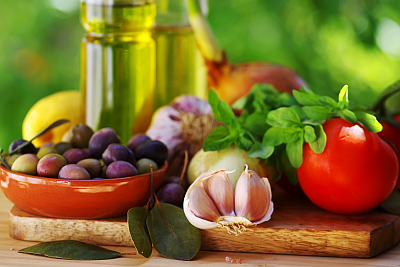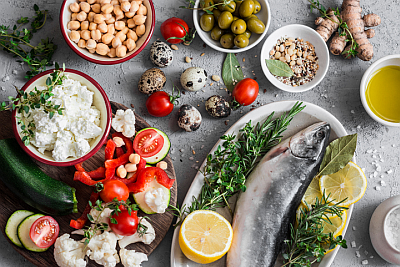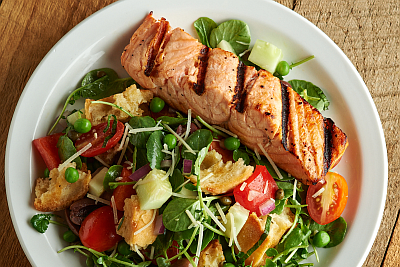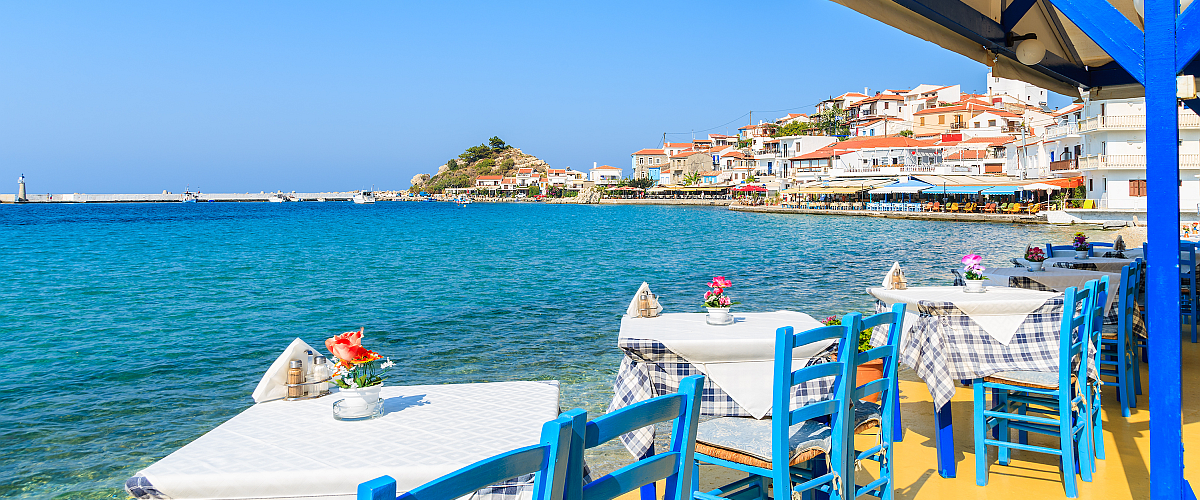What do you think of when you think about the Mediterranean? Rocky cliffs, white sand beaches, sun-drenched hillsides, the shimmering blue sea?
We think of olive oil made from olives picked by hand, fresh seafood fished by local fisherman, and vegetables grown in a backyard garden tended for generations by the same family. Our chefs think about some of the most delicious food on the planet and our dietitians think about a style of eating that research is showing to be one of the healthiest.
While some people view the Mediterranean diet as just that—a diet—it’s actually more a melting pot of the eating patterns and coastal cuisines of at least 16 countries that border the Mediterranean Sea, including Greece, Spain, Italy, France and Lebanon. This mix of cultures, combined with the unique climate of the area, lends itself to an almost infinite blend of culinary possibilities, all with an unforgettable taste.
 “That’s the beauty of this way of eating,” says Aramark Registered Dietitian Gaia Di Giacomo (pictured), who was born in South Italy and still has family in the region. “There is no single diet, no one ‘right’ way to do this. It’s more about the combination of healthy ingredients.”
“That’s the beauty of this way of eating,” says Aramark Registered Dietitian Gaia Di Giacomo (pictured), who was born in South Italy and still has family in the region. “There is no single diet, no one ‘right’ way to do this. It’s more about the combination of healthy ingredients.”
WHY MEDITERRANEAN DIET?
The Mediterranean diet has been gaining in popularity for good reason—it’s delicious and healthy! Mostly plant forward, this style of eating emphasizes a variety of fruits, vegetables, whole grains, beans and legumes, as well as fish and other foods with healthy fats like nuts and olive oil. It also includes moderate amounts of other proteins like eggs, dairy, and poultry, and limited amounts of red meat.
“A move to foods inspired by the Mediterranean would benefit many of us,” says Gaia. “Only 1 in 10 Americans today meet the daily recommended amount of fruits and vegetables.”
The fruits and vegetables in Mediterranean cuisine provide your body with a rich variety of vitamins and antioxidants, minerals like iron and calcium, and fiber. And the way they’re prepared, with olive oil and fresh herbs and spices makes them uniquely delicious.
 “Similarly, the fish, nuts and oils in traditional Mediterranean dishes provide mono- and polyunsaturated fats your body needs,” Gaia continues. Unique to the Mediterranean diet, as well, is what is rarely on the plate. “Traditional Mediterranean cuisine includes only small amounts of highly processed carbs and high sugar foods or beverages.”
“Similarly, the fish, nuts and oils in traditional Mediterranean dishes provide mono- and polyunsaturated fats your body needs,” Gaia continues. Unique to the Mediterranean diet, as well, is what is rarely on the plate. “Traditional Mediterranean cuisine includes only small amounts of highly processed carbs and high sugar foods or beverages.”
When put all together, this nutritious eating pattern has been associated with improved cognition and mental health, as well as reduced risk for diabetes, cancer and other chronic diseases. In addition, research indicates that eating a Mediterranean diet rich in healthy fats and lower in saturated fat and cholesterol provides protection against heart attack and stroke.
It’s no wonder, then, that the Mediterranean diet has even made it onto UNESCO’s Intangible Cultural Heritage list.
KEY INGREDIENTS AND FLAVORS OF THE MEDITERRANEAN DIET
- Fresh Produce: Vegetables like tomatoes, spinach, cucumbers, onions and carrots and fruits like apples, bananas, figs, dates, grapes, melons and more
- Proteins: Beans and legumes like lentils, chickpeas, butter beans, white beans, fava beans, green beans and peas with less focus on dairy, poultry and eggs
- Healthy mono- and polyunsaturated fats: Nuts and seeds like walnuts, almonds, cashews; flax and sunflower seeds; olive oil; and omega-3-rich fish like salmon, sardines and mackerel
- Whole Grains: In the form of bread, pasta, rice, couscous, barley, buckwheat, bulgur, farro, millet, oats, and more
 TIPS TO GET STARTED
TIPS TO GET STARTED
- Pick Your Produce: Load up on fresh produce in-season if you can! It’s often less expensive and tastier, and it encourages variety. Leafy greens and other veggies like carrots, peppers, tomatoes and beets can also add a fun pop of color to your plate.
- Kick up the Spice: Seasoning with spices and fresh herbs like basil, oregano, mint or dill can add so much flavor to your dishes that you won’t even miss the salt.
- Make Substitutions: Replace butter with olive oil when cooking. Try swapping fish or a plant-based protein like chickpeas or other beans a few times a week in place of meat. You can also opt for whole grain versions of your favorites, such as brown rice and whole wheat bread, but don’t forget to try other grains like quinoa, barley, farro and millet or others listed above.
GET INSPIRED
Shifting the way you eat can be intimidating at first, but starting with even one small change at a time can make a big difference. Don’t be afraid to try out a new recipe, type of food, texture or cooking technique. Some of our favorites are grilling, searing or sautéing, all of which deliciously transform both your proteins and your veggies!

Get Recipe: Grilled Salmon Panzanella Salad
In need of some more Mediterranean inspiration? Check out these recipes:
- Greek Omelet
- Baked Lemon Mediterranean Pasta Salad
- Mediterranean Cranberry Couscous
- Avocado Tzatziki
- Grilled Salmon Panzanella Salad
- Caprese Avocado Toast
The Mediterranean diet may be called a “diet” because of its health benefits, but once you try it out, we think that you’ll love it for its flavors.
Note: Since everyone’s health history and nutritional needs are so different, please make sure that you talk with your doctor and a registered dietitian to get advice about the diet and exercise plan that‘s right for you.

